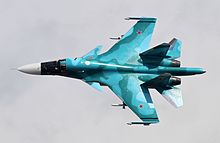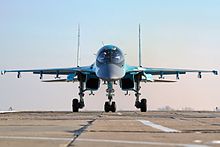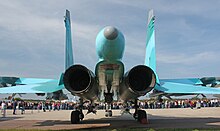Sukhoi Su-34
| Sukhoi Su-34 | |
|---|---|
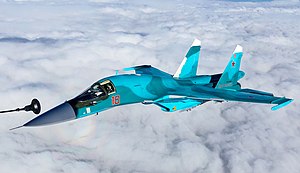 Sukhoi Su-34 |
|
| Type: | Fighter bomber |
| Design country: |
|
| Manufacturer: | |
| First flight: |
April 13, 1990 |
| Commissioning: |
December 9, 2011 |
| Production time: |
In series production since 2006 |
| Number of pieces: |
138 in the Air Force + 7 prototypes (as of October 3, 2019) |
The Sukhoi Su-34 ( Russian Сухой Су-34 , NATO code name : Fullback ), as an export version under the designation Su-32 , is a two-seater fighter - bomber developed in the Soviet Union by the Sukhoi design office , whose series production started in April 2006. Official delivery to the Russian Air Force began on July 31, 2007 .
Development and history
prehistory

In the early 1980s, the Soviet front-line aviation forces had three types of fighter - bomb aircraft : the Su-17 , the MiG-27 and the heavy front-end bomber Su-24 . Above all, a changed battle management and increasing inflation rates made the development of multi-purpose combat aircraft necessary. Aircraft were required that could be used both as interceptors and as fighter-bombers . In Europe the Panavia Tornado flew in the meantime and the Americans transformed the combat trainer F-15B into the multi-purpose fighter F-15E Strike Eagle . Although the light front fighter MiG-29 and the heavy air superiority fighter Su-27P or Su-27S were aircraft that were on par with the F-15E in aerial combat , none of the above-mentioned models was capable of heavy blows against ground targets to lead in the hinterland of the enemy or against sea targets such as carrier formations. The Su-27P was purely designed for air combat and the Su-27S was out of air-to-air missiles only unguided air-to-surface missiles to fire short range.
development
On January 21, 1983, under the orders of the Minister of Aviation Industry, the OKB Sukhoi began developing a heavy fighter-bomber. The demands of the air force were high maneuverability, high weapon loading, high speed and a wide operational radius. The Su-27 served as a template. The special shape of the fuselage and the wings made extreme air combat maneuvers possible . The weapons load was also extensive with six tons and large internal tanks enabled combat radii of more than 2000 kilometers. The powerful Al-31F engines brought the machine to Mach 2.35. Based on the Su-27 and its modifications under development, the successor for the front bomber Su-24 was planned. However, the new machine should also replace the Tupolev Tu-22M medium -range bomber . Sukhoi chief designer Rolan Martirossow initially gave the project the factory designation T-10W, later the designation Su-27IB (IB = Istrebitel Bombardirowschtschik = fighter-bomber) was announced.
With the development of radio-electronic complex for weapons steering the union was Leninez in Saint Petersburg (then Leningrad) commissioned. The engine was again developed by NPO Saturn . The air-to-air missiles were to be from Wympel and the air-to-surface missiles from Raduga . The construction office for equipment construction Totschnost in Tula received the order for the on- board cannon . The concrete starting point for the T-10W was the unfinished prototype of the on-board combat trainer T-10KM-2 with seats arranged side by side. Originally, only upgrading the Su-27UB was considered, but the strain on the crew would have become too high on long-haul flights in the narrow cockpit.
In Novosibirsk , a new front part of the fuselage with an armored cabin was finally made and attached to the T-10KM-2. Due to the seats lying next to each other, the front part of the fuselage was not given a round, but a flat elliptical cross-section with sharp side edges that merged into the front wing consoles. Access to the cockpit is via the nose gear shaft. Since the weight of the aircraft was mainly shifted to the front, the nose landing gear was fitted with double tires and the main landing gear was designed as a tandem. The air intake ducts, which could no longer be regulated, were also significantly changed. This was possible because the aircraft was to be used as a fighter-bomber, especially in low-level flight close to the ground, and thus the maximum speed at great heights became less important.
Testing and series production
On April 13, 1990, the first prototype of the Su-27IB ( Blue 42 ) took off for its maiden flight . In contrast to the later prototypes and series models, the machine did not yet have the tandem main landing gear. The machine was flown by Yevgeny Alexejewitsch Ivanov over the Research Institute of the Russian Air Force in Akhtubinsk .
The public first saw the new aircraft on February 13, 1992 at a meeting of the CIS countries in Matschulistsche near Minsk . The organizers of the show apparently expected that with the presentation of the machine, state funds would be granted to continue testing the Su-27IB. Information about the new aircraft had become public earlier, because in the summer of 1990 the aircraft was briefly at the Novofyodorovka airfield near the city of Saki on the Black Sea , where the test center of the Soviet naval aviators was located. The background to this was the visit of the then President of the Soviet Union, Mikhail Gorbachev , to the aircraft carrier Tbilisi , today Admiral Kuznetsov , who was on a factory trip after deck tests of the Su-27K , MiG-29K and Su-25UTG and subsequent modifications. The OKB Sukhoi took this opportunity to present the new multi-purpose combat aircraft. The test pilot carried out a landing approach to the Tbilisi with the Su-27IB , but intercepted the machine shortly before touchdown. The machine could not touch down because of the missing catch hook and it was much too heavy for the jump start. The pictures went around the world and it was assumed that the machine had landed on the carrier. In the West, for example, they first spoke of the new airborne combat trainer Su-27KU.
On December 18, 1992, the first pre-series machine T-10W-2 ( Blue 43 ) started, now with a tandem main landing gear. It was the second prototype in series configuration. The fighter-bomber was designed in such a way that it could effectively attack highly secured ground targets in all weather conditions, day and night. The tail cone has also been enlarged to make room for two brake screens and additional decoys. In March 1994 a Su-27IB was transferred non-stop from Novosibirsk to Zhukovsky and presented there as the Su-34. T-10W-3 was a break test cell. It was followed by the T-10W-4 ( White 44 , first flight December 26, 1996), T-10W-5 ( White 45 , first flight on December 28, 1996) and T-10W-6 ( White 46 , first flight on December 27 , 1996) . December 1997). Weapon system testing began with the T-10W-4, the T-10W-5 had the Sch141 Chishchnik mission system for the first time , which was tested from 1996. T-10W-4 was also flown with it from the end of 1996. In 1999 this machine was given the Platan optical system . Equipped in this way, she escorted Su-24M front-bomb aircraft to exercises near Aschuluk in April 2000 . The EloKa system L-175W Chibiny was tested above all . In 2000 and 2002 two machines were used on a trial basis over Chechnya. In 1999 the T-10W-6 was equipped with new computers of the BtsWM-386 series, which replaced the old argon . Leninez also used a converted Tu-134 Sch as a test carrier for the W004 radar. Two other pre-series machines - T-10W-7 ( White 47 ) and T-10W-8 ( White 48 ) - flew on December 22, 2000 and December 20, 2003. The tests had dragged on very slowly in between. However, when General Vladimir Mikhailov was appointed Commander-in-Chief of the Air Force in April 2002, he pushed for the program to be accelerated, or else threatened to cancel it. After 150 test flights in 2002, around 130 missions were flown in the first half of 2003 alone. The Air Force, however, wanted further improvements even though the first phase of state testing was over. NAPO brought these improvements to the T-10W-8. On September 30, 2006, the repetition of the state experiments was completed. In this phase, GLONASS -controlled bombs of the KAB-500 series were dropped for the first time.
However, the designation Su-32FN was just a new name for one and the same aircraft. It was not until the last visit by the chief of the air force to the manufacturer in Novosibirsk that it was decided that the machine would be included in the Russian air force as a Su-34. However, the manufacturer designates the planned export models as Su-32NF and Su-32M.
The Su-34 completed state testing in 2005 and was placed in the service of the Russian Air Force. The first supply contract for the Russian air force was signed in March 2006 with the NAPO manufacturing plant in Novosibirsk. Finally, the first production aircraft, the Rote 01 , flew on October 12 and was handed over to the air forces together with the 02 on December 15, 2006. The Red 01 went to Lipetsk for the 4th ZBP i PLS, the Red 02 stayed in Novosibirsk until July 2007 because it was not yet fully equipped. In the meantime, the ground staff has also been trained on it. Then she took part in weapons system tests in Akhtubinsk. One machine was delivered in 2008, and two Su-34s in 2009. On December 28, 2010, the first four machines followed a contract concluded in 2008 for 32 fighter-bombers for approx. 27.7 million euros each. The official commissioning took place on December 9, 2011 at the Voronezh base. In 2012, another contract was signed for 92 Su-34s, which should be delivered by 2020. The unit price was a little over a billion rubles, around $ 15 million, with a total volume of 1,000 billion rubles. In the long-term plans up to 2020 and beyond, at least 140 Su-34s were originally planned by the Russian Air Force. In 2019, the signing of a contract for the production of 48 pieces was foreseeable, which should be carried out in the years 2019 to 2027. According to older information, those interested in export should be Algeria, Libya, Syria and possibly Iran. The F-15E Strike Eagle can be viewed as an analog weapon system .
The Su-34 is to replace the Su-17 , Su-24 , MiG-27 , Tu-22M and Tu-142 models , but in significantly fewer numbers than their predecessors. A reconnaissance variant of the Su-34 was also planned, but since the fighter-bomber version already has a good reconnaissance potential and can be equipped with appropriate containers, a new development was dispensed with.
After the commissioning of the first two machines, the Su-34 was given the NATO code name Fullback by NATO . The unusual front torso of the machine led to the nickname утёнок (utjonok) (in English: ducklings ) or утконос (utkonos) (in English: platypus ).
Mission history
Suchoi Su-34s of the Russian Air Force have been used against ground targets as part of the military operation in Syria since September 30, 2015 . The deployment takes place in the context of the Syrian civil war .
Construction and technology
Aerodynamic design
The Su-34 is aerodynamically designed similar to the Su-27 and Su-35 . Although it is conventionally equipped with a horizontal stabilizer, it also has duck wings , which are supposed to increase maneuverability . Further changes to the shape of the fuselage were the already mentioned wider fuselage bow and the enlarged tail boom between the engines. The shape of the bow of the fuselage, the elimination of the stabilizing fins under the vertical stabilizers, the installation of radar-absorbing materials and a radar protective coating have significantly reduced the radar signature. Like the Su-27K, Su-30 and Su-35, the Su-34 now also has an air refueling system that gives it a practically global range with three to four air refueling. The only limits here are the resilience of the crew.
The wider fuselage nose allows a juxtaposition of the crew members on the Zvezda K-36DM - ejection seats . In order to counteract the fatigue of the crew on long-distance missions (ten hours and more with air refueling), increased emphasis was placed on comfort. The relatively large back of the fuselage behind the cockpit has a small on-board kitchen and a steel cylinder with a lockable funnel end as a toilet replacement. It should even give the crew members enough space to stand upright and rest. In addition, the adjustable seats allow a crew member to rest in a lying position. The pressure ventilation makes it possible to dispense with oxygen masks . In order to be able to hermetically seal the pressurized cabin more easily, the crew members climb the cockpit like a strategic bomber via a ladder in the nose gear shaft. The cockpit is provided with a 17 millimeter thick and 1.48 ton heavy titanium armor .
Avionics
Weapon system testing had started with the T-10W-4. The Sch-141 Chishchnik ( Russian Хищник , predator) mission system of the machine includes the Leninez W004 radar with passive electronic beam swiveling ( PESA ), the L-175W Chibiny system for electronic warfare ( radar and missile warning receivers , active jammers, chaff / torch throwers) ), the Platan target search system with video camera and laser target illuminator as well as a navigation, display and communication complex. The K102 system from RPKB from Ramenskoje is used for electronic control . An electro-optical navigation and destination container is also planned.
The W004 Chishchnik radar device from OKB Leninez is used as the radar . The radar uses a passive phase-guided radar antenna ( PESA ). It works in the centimeter range with a wavelength of 3 cm, with a maximum transmission power of 15 kilowatts . The swivel angle of the antenna is ± 60 degrees in azimuth and elevation . The W004 radar can capture both air and ground targets. An air target the size of a combat aircraft can be detected within 90 km. A ground target the size of a battle tank can be detected up to a distance of 30 km. The radar can also be used to create high-resolution radar maps up to a distance of 150 km. The radar can also be used as a terrain follower radar .
The navigation is done by a receiver in combination with an inertial platform that is compatible with both GLONASS and GPS and enables an accuracy of up to one meter. In order to achieve this accuracy under GPS, Russia would have to acquire a license for the military GPS in order to get hold of the necessary keys. Without these keys, only the public inaccurate GPS channel is available. A radar warning receiver, an infrared sensor and a laser warner secure the warning against attacks. The crew can also activate a jammer and the usual IR flares.
Technical specifications
| Parameter | Data |
|---|---|
| Type | Heavy tactical fighter-bomber |
| crew | 2 |
| length | 23.34 m |
| span | 14.70 m |
| height | 6.09 m |
| Wing area | 62.04 m² |
| Wing loading |
|
| Empty mass | approx. 22,500 kg |
| normal takeoff mass | 38,240 kg |
| Max. Takeoff mass | 44,360 kg |
| Top speed |
|
| Service ceiling | 14,400 m |
| Use radius |
|
| Transfer range |
|
| Max. Gun load | 8200 kg |
| Engines | two turbofan engines Saturn / Ljulka AL-35F |
| Thrust per engine |
|
| Thrust-to-weight ratio |
|
Armament
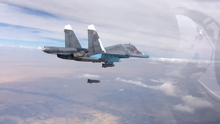
- Fixed armament in the bow
- 1 x 30 mm automatic cannon GRYAZEV-SHIPUNOV GSH-301 (9A-4071K) with 150 rounds of ammunition
- Gun loading of 8200 kg (overload 9000 kg) at twelve external load stations
- Air-to-air guided missile
- 6 × AKU / APU-470 start rails for one R-27R (AA-10 "Alamo-A / C") each - semi-active radar-guided for medium-haul routes
- 6 × AKU / APU-470 starting rails for one R-27T each (AA-10 "Alamo-B / D") - infrared-controlled for medium-haul routes
- 8 × AKU-170 starting rails for one R-77 (AA-12 "Adder") each - radar-guided for long distances
- 8 × P-72-1D starting rails for one R-73M2 each (AA-11 "Archer") - infrared controlled for short distances
- Cruise missiles
- 2 × AKU-58 starting rails for a Ch-59 "Owod" (AS-13 "Kingbolt") - TV-controlled
- 2 × AKU-58 launch rails for a Ch-59M “Owod-M” (AS-18 “Kazoo”) - radar-guided against sea targets
- 3 × starting rails for one “ calibr ” rocket each , e.g. B. 3M54A1, 3M14A
- 2 × launch rails for one Ch-101 each - strategic cruise missile with stealth capability, conventional 400 kg warhead, Ch-102 thermonuclear warhead
- Air-to-surface guided missile
- 6 × launch rails for 1 × Ch-35 "Uran" (3M24 or AS-20 "Kayak") each - radar-guided anti-ship missile
- 6 × AKU-58M starting rails for 1 × GosMKB Raduga Ch-38ML / MA / MT / MK each - laser / radar / infrared or GLONASS guided
- 6 × AKU-58M launch rails for 1 × Ch-31 P (AS-17 "Krypton") each - passive anti-radar guided missile
- 6 × AKU-58M launch rails for 1 × Ch-31A (AS-17 "Krypton") each - radar-guided anti-ship missile
- 6 × AKU-58M starter rails for 1 × Ch-29 L (AS-14 "Kedge") each - laser-guided
- 6 × AKU-58M starter rails for 1 × Ch-29T (AS-14 "Kedge") each - TV-controlled
- 6 × APU-68UM3 starting rails for 1 × Ch-25 MT (AS-10 "Karen") each - TV-controlled
- 6 × APU-68UM3 starting rails for 1 × Ch-25ML (AS-10 "Karen") each - laser-guided
- 6 × PU-O-25 rocket launch containers for 1 × KB Totschmasch S-25LD each - laser-guided, caliber 340 mm
- Unguided air-to-surface missiles
- 6 × B8M1 rocket launch containers for 20 × unguided KB Totschmasch S-8 air-to-ground missiles; Caliber 80 mm
- 6 × B13L rocket launch containers for 5 × unguided KB Totschmasch S-13 air-to-ground missiles each ; Caliber 122 mm
- 6 × PU-O-25 rocket launch containers for an unguided KB Totschmasch S-25OFM air-to-surface missile; 340 mm caliber
- Guided bombs
- 3 × BD-4 suspension for 1 × region JSC KAB-1500 L-F ( laser-guided 1500 kg bomb)
- 3 × BD-4 suspension for each 1 × region JSC KAB-1500S (satellite navigation-guided 1500 kg bomb)
- 6 × BD-3U suspension for 1 × region JSC KAB-500 L (laser-guided 500 kg bomb)
- 6 × BD-3U suspension for 1 × region JSC KAB-500Kr (television-controlled 500 kg bomb)
- 6 × BD-3U suspension for each 1 × region JSC KAB-500S (satellite navigation-guided 500 kg bomb)
- Free falling bombs
- 3 × FAB-1500M-46 (1500 kg high explosive bomb )
- 8 × FAB-500T (500 kg high explosive bomb)
- 8 × ODAB-500 PM (500 kg aerosol bomb )
- 8 × RBK-500 (500 kg cluster bomb )
- 12 × BetAB-500SchP (500-kg anti-slope bomb )
- 16 × OFZAB-500 (500 kg incendiary bomb )
- 16 × FAB-500M-62 (500 kg high explosive bomb)
- 6 × multiple bomb carriers MBD3-U6-68 with 3–4 × RBK-250-275AO-1SCh each (280 kg cluster bomb with AO-10 bomblets, max. 22 bombs)
- 6 × multiple bomb carriers MBD3-U6-68 with 3–4 × basalt FAB-250M-62 each (250 kg free-fall bomb, max. 22 bombs)
- 6 × multiple bomb carriers MBD3-U6-68, each with 6 × basalt FAB-250 (250 kg high explosive bomb, max. 36 bombs)
- 8 × multiple bomb carriers MBD3-U6-68 with 6 × basalt FAB-100 each (100 kg high-explosive bomb, max. 48 bombs)
- 6 × multiple bomb carriers MBD3-U6-68, each with 6 × basalt OFAB-100-120TB (100 kg fragmentation bomb, max. 36 bombs)
- Nuclear weapons
- 1 × TN-1000 (30 kT tactical free-fall nuclear bomb )
- 1 × 6U-57 (tactical free-fall nuclear bomb)
- 1 × 8U-49 (tactical free-fall nuclear bomb)
- 1 × 8U-63 (tactical free-fall nuclear bomb)
- 1 × RN-28 (tactical free-fall nuclear bomb)
- 1 × 244N (tactical free-fall nuclear bomb)
- 1 × RN-24 (tactical free-fall nuclear bomb)
- External container
- 7 × Basalt KMGU -2 (270 kg submunition container for small bombs and mines)
- 3 × drop-off additional tanks PTB-3000 for each 3000 liters of kerosene (only for transfer flights)
- 1 × Tekon / Elektron APK-9 radio data transmission container as a relay for the steering signals for the Ch-29, Ch-59 and KAB-500Kr
- 1 × UOMZ Sapsan (electro-optical target lighting container)
- 1 × jam container KNIRTI SAP-14
- 1 × air refueling tank UPAS-1A with hose reel and basket
Self-defense systems
Seven APP-50A decoy launchers for 14 × 50 mm decoys cartridges each are installed in a block in the tail boom. There are a total of 98 decoy cartridges.
User states
Current user
-
 Russia - As of October 2019, there are 138 series aircraft in service with the Russian Air Force .
Russia - As of October 2019, there are 138 series aircraft in service with the Russian Air Force .
Another 7 flying prototypes are at the manufacturer's and the Air Force for testing. The Russian Defense Ministry plans to put at least 200 Su-34s into service.
Future user
-
 Algeria - At the end of 2015, 12 Su-34s were ordered for the Algerian Air Force . The overall contract for the modernization of the Algerian Air Force has a volume of 7.5 billion US dollars , half a billion US dollars of which is for the 12 Su-34s, which, however, had not yet been delivered by January 2018.
Algeria - At the end of 2015, 12 Su-34s were ordered for the Algerian Air Force . The overall contract for the modernization of the Algerian Air Force has a volume of 7.5 billion US dollars , half a billion US dollars of which is for the 12 Su-34s, which, however, had not yet been delivered by January 2018.
Incidents
- On June 4, 2015, a Russian Air Force Su-34 rolled over the runway and overturned while landing at Buturlinovka Air Force Base due to a defective braking parachute and excessive speed. The two crew members were uninjured.
- On January 18, 2019, at 8:07 a.m. Moscow time, two Su-34s of the Russian Air Force collided during a training flight over the Sea of Japan around 35 km from Sakhalin . This led to the crash of the two unarmed machines, and the crews catapulted themselves. One co-pilot was found alive and rescued, while two other crew members could only be recovered dead. The fourth was still being searched for. The probable cause is human error, as the interrogation of the surviving crew member revealed. The planes were flying in a line formation and visibility was poor due to heavy cloud cover. The aircraft behind lost the aircraft in front of it and collided with the rear of the aircraft while catching up.
literature
- A. Micheew, A. Fomin: Su-34 fighter bomb aircraft . Elbe-Dnjepr, Klitzschen 2006, ISBN 978-3-933395-73-3 .
Web links
- Overview of the Su-27 family from airpower.at
- Su-34 site of the manufacturer (Russian)
- Website about Su-34
- Russian news agency Novosti on the Su-34
- Photo gallery of the production process on EnglishRussia.com
- Rossiya 2 Poligon , Su-34
Individual evidence
- ↑ FliegerRevue February 2011, p. 8, First Su-34 bombers delivered
- ↑ FliegerRevue February 2012, p. 8, First Su-34 put into service
- ↑ Production of military aircraft in Novosibirsk could be stopped , Vedomosti, October 8, 2019
- ^ Russian air strikes in Syria continue. Deutsche Welle, October 7, 2015, accessed on October 8, 2015 .
- ↑ Expert: Russia sends 40 to 60 airmen and two protection battalions to Syria. Sputnik, September 30, 2015, accessed October 2, 2015 .
- ↑ a b Overscan’s guide to Russian Military Avionics ( Memento of the original from July 7, 2012 in the web archive archive.today ) Info: The archive link was automatically inserted and not yet checked. Please check the original and archive link according to the instructions and then remove this notice.
- ^ Jefim Gordon : Soviet / Russian Aircraft Weapons Since World War Two. Midland Publishing, 2004, p. 45.
- ↑ Archived copy ( memento of the original from June 23, 2012 in the Internet Archive ) Info: The archive link was inserted automatically and has not yet been checked. Please check the original and archive link according to the instructions and then remove this notice.
- ^ Jefim Gordon : Soviet / Russian Aircraft Weapons since World War Two. Midland Publications, 2004, p. 175.
- ↑ bmpd: ВКС России получили первые бомбардировщики Су-34 программы 2017 года. In: LiveJournal. bpmd.livejournal.com, May 23, 2017, accessed on March 15, 2019 (in Russian, among others, of the 102 Su-34s, minus the 7 prototypes and 4 Su-34s of 2017 production, 91 Su-34 series machines were manufactured up to Delivered at the end of 2016).
- ↑ Источник раскрыл планы производства бомбардировщиков Су-34 на 2017 год. In: Лента.Ру. lenta.ru, February 6, 2017, accessed on March 15, 2019 (in Russian, among other things, of a further 16 Su-34s, only 14 Su-34s were delivered in 2017 according to more recent information [1] ).
- ↑ Два новых бомбардировщика Су-34 поступили в авиаполк ЦВО в Сибири. In: Министерство обороны Российской Федерации. structure.mil.ru, December 6, 2018, accessed on March 15, 2019 (Russian, including a further 14 Su-34s were delivered in 2018).
- ↑ Четыре самолета Су-34 поступят в Центральный военный округ. structure.mil.ru, December 16, 2018, accessed March 15, 2019 (Russian).
- ↑ СМИ: погибшие летчики Су-34 запутались в стропах. In: военное.рф. военное.рф, January 20, 2019, accessed on March 15, 2019 (Russian, among other things, according to recent reports, 2 Su-34s crashed after colliding with each other).
- ↑ Семь Су-34 и два транспортных самолета Ан-148-100 поступили по ГОЗ с начала года в ЦВО. In: Министерство обороны Российской Федерации. structure.mil.ru, March 11, 2019, accessed March 15, 2019 (Russian).
- ↑ Смешанный авиаполк ЦВО в Челябинской области пополнился тремя новыми истребителями-бомбащрдирстребителями-бомбащрдир. In: Министерство обороны Российской Федерации. structure.mil.ru, June 11, 2019, accessed on June 14, 2019 (Russian, among others).
- ↑ Авиаполк под Челябинском завершил перевооружение на самолеты поколения 4 ++. In: Министерство обороны Российской Федерации. structure.mil.ru, October 3, 2019, accessed on October 4, 2019 (in Russian, among other things another 3 Su-34s were put into service).
- ↑ bmpd: ВКС России получили первые бомбардировщики Су-34 программы 2017 года. In: LiveJournal. bpmd.livejournal.com, May 23, 2017, accessed on March 15, 2019 (Russian, among other things, a total of 7 prototypes were made).
- ↑ Су-34 по прозвищу "Утенок": лучший бомбардировщик армии России. In: ТАСС. tass.ru, August 22, 2016, accessed March 15, 2019 (Russian).
- ↑ Le Su34 officiellement commandé par l'Algérie. menadefense.net, January 6, 2016, accessed January 6, 2016 (French).
- ↑ Oscar Nkala: Algeria Orders 12 Su-34 'Fullback' Fighter-Bombers from Russia. In: Defense News. defensenews.com, January 5, 2016, accessed January 6, 2016 .
- ^ The International Institute for Strategic Studies (IISS): The Military Balance 2018 . 1st edition. Routledge, London 2018, ISBN 978-1-85743-955-7 , pp. 328 (English, as of January 2018).
- ↑ a b Russian Defense Ministry has rescued the co-pilot of the Su-34 crashed into the Sea of Japan. In: ruaviation.com. January 18, 2019, accessed January 19, 2019 .
- ↑ Rescuers find another body at the crash site of Su-34 in Sea of Japan. In: ruaviation.com. January 18, 2019, accessed January 19, 2019 .
- ↑ Спасатели нашли тела двух летчиков Су-34. In: tass.ru. January 18, 2019, accessed on January 19, 2019 (Russian, 9:42 p.m. Moscow time (= 19:42 CET)).
- ^ Two dead, one missing after Russian fighters collide over Sea of Japan. In: cp24.com. Retrieved January 19, 2019 (English, AP notification, 4:36 PM EST (= 22:36 CET)).
- ↑ Источник: спасенный штурман Су-34 рассказал о моменте столкновения самолетов. In: tass.ru. TASS, January 25, 2019, accessed January 25, 2019 (Russian).
